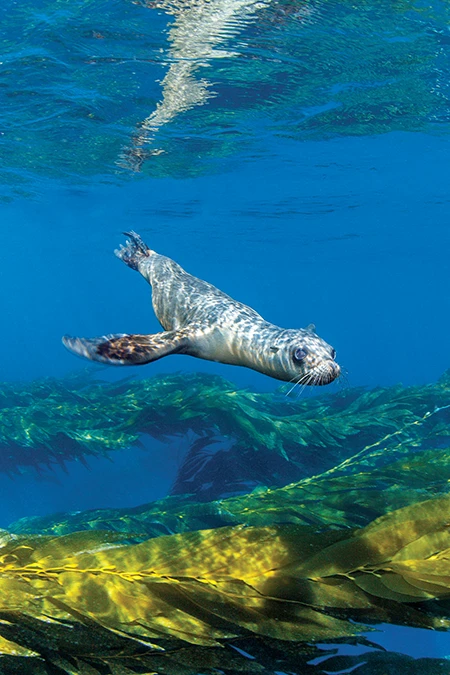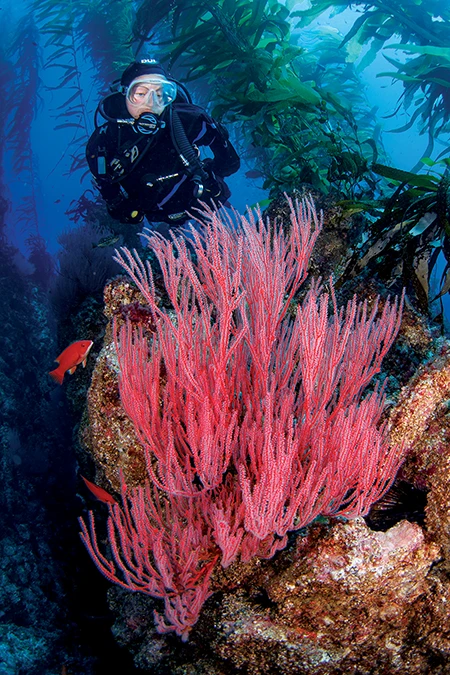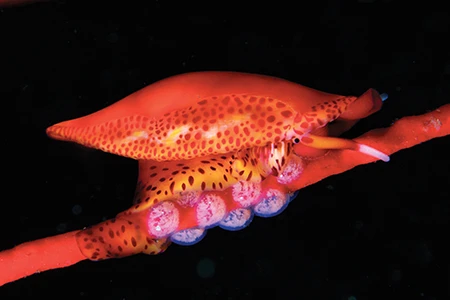A crash course
It’s 5 p.m., officially boarding time, and the floodgates have opened. Eager, impatient divers synchronously emerge from their cars and begin to haul carts full of gear down the dock. We’re right there with them, jostling to get a prime spot for our tanks. It’s not our proudest display of patience, but the crew members who are there to greet us just laugh at the display, familiar with the excitement of divers who will soon be underway to the California Channel Islands.
These eight islands are legendary to divers. Referred to as “North America’s Galápagos,” they’re said to have been one of Jacques Cousteau’s favorite dive destinations, and divers travel from all over California — and beyond — to experience them every year (including divers who have sworn never to set foot or fin in temperate water).


They are also a study in contrast. They rose individually from the sea floor millions of years ago, and each one boasts a unique ecosystem. Summarizing them as a single destination is futile. In addition to individual island differences, there’s a distinction between the Northern and Southern Channel Islands, a division between those that are part of the Channel Islands National Park and those that aren’t, and huge disparities in ease of accessibility from one island to the next.
We take a minimum of two three-day liveaboard trips to the Channel Islands each autumn. Unless you have access to a hardy and well-fueled private boat, a week (preferably much more) of free time, and generous luck with marine conditions, it’s nearly impossible to visit all the California Channel Islands — which are scattered along a 160-mile (257-kilometer) stretch of ocean — in one go. Our twofer visits are among the best diving we do each year, but they’re hardly enough to adequately scratch the surface of these glorious destinations, which contain an array of reefs, wrecks, kelp forests, diverse large and small marine life, and technical diving opportunities (including cave diving).
Southern Hospitality
Tonight, we’re headed to the Southern Channel Islands, a quartet that includes San Clemente, San Nicholas, Santa Catalina, and Santa Barbara (Santa Barbara Island is the only southern island that is part of the Channel Islands National Park). After an intensive safety briefing and evacuation drill, we’re pulling away from the dock and making our way out of the harbor.
The U.S. Navy owns and operates San Clemente Island, the southernmost of the archipelago, and although there are usually a few hundred personnel posted to a base on the island, the public is not permitted on shore. That’s fine with us since we’re focused on being underwater, but access to dive sites and anchorages relies on the Navy’s ever-changing operations schedule (scisland.org). We’ve been checking the website obsessively all week, and we’re concerned the island will be closed to diving. Fortunately, the captain has confirmed that a good portion of the island’s perimeter is open for marine activities tomorrow, so we hit our bunks, hoping to sleep through much of the 65-mile (105-km) trip.
San Clemente welcomes us with one of the smoothest crossings to the islands we’ve experienced. You would think the anchor dropping before 6 a.m. would make people grumpy, but our group is well-rested and ready to go — almost everyone is on deck enjoying coffee and a glorious sunrise not long after we’re awakened. Since everyone’s already on deck, the crew provides an early dive briefing, and everyone begins to gear up. We’re delighted to recognize that we’re anchored in the Pyramid area, which contains some of the most stunning dive sites San Clemente has to offer, including the Underwater Arch, The Boilers, y China Point. These vistas feature lush kelp and an array of most-wanted marine creatures, such as harbor seals, soupfin sharks, and bat rays. The water is exceptionally clear and blue today, and descending into the towering kelp forest behind the boat is like swimming directly into the archetypical Southern California dive site. During one of our surface intervals, we notice a flash of silver at the edge of a nearby kelp bed, followed by streams of jumping fish. We hurriedly get geared up and jump back in to discover a huge school of baitfish herded by the most delighted (and chunky) sea lion on the planet.


The ocean is still extraordinarily calm, giving us a perfect window to travel to remote Santa Barbara Island. This low-lying, single square mile of land is the smallest of California’s Channel Islands; its isolation and small size provide minimal shelter from wind and swells, so it’s only accessible under the best conditions. We are undoubtedly fortunate in that regard, and we score another easy travel night. It’s so smooth that the crew dropping anchor is the only disturbance that rouses us from our bunks.
On deck, we quickly recognize that we’re on the western side of Santa Barbara. The spectacular dive sites on this side of the island — standouts like Arch Reef, hydrocoral-dotted Hidden Reef, kelp-encircled Sutil Island, and even the sandy patches — hold extraordinary marine life. The phenomenal diversity of this island truly reflects the convergence of the cold California current and the warmer Southern California countercurrent that’s a key feature of the Channel Islands — but Santa Barbara always seems uniquely supercharged to me, probably because everything is packed into such a diminutive area. Our dives in this area deliver an incredible mix of sightings: garibaldi, California sheephead wrasse, giant black sea bass, a harbor seal, and some rare nudibranch species. We’re a sad group when the captain announces that the wind here is forecast to kick up, so we’ll be doing one more dive on the island’s slightly more protected eastern side, and then we’ll need to head toward Catalina.
As the crew prepares to move the boat, we spot San Nicolas Island, the most remote of the Channel Islands archipelago, and I pause to admire the hazy silhouette of the one Channel Island that has eluded me for nearly 20 years. Like San Clemente, the Navy owns San Nic, though it is only used for training and weapons testing; there are no bases on the island. San Nic’s Three Mile Reef y el cercano Begg Rock are known for an abundance of rockfish, lingcod, and spiny lobster, so the island is legendary, especially among spearfishers and lobster hunters. Sadly, wind and swell have consistently prevented me — and most other California divers — from getting there. Given the forecast for tomorrow, there is no chance we’ll make it this trip either; I’ll just have to hope for next time.
As we approach the eastern side of Santa Barbara, we’re hit with the cacophony and aroma of one of the largest California sea lion rookeries in Southern California. Fortunately, once we’re below the surface, the smell is gone, the barking is muffled, and it’s not long before we’re bombarded by a melee of bitey sea lion pups just old enough to venture from their parents’ watchful gazes.
We spend our final day at Catalina Island, the most easily accessible of the Channel Islands and the only one inhabited by full-time residents. Before the wind becomes prohibitive, we get in a dive at Farnsworth Banks, a series of hydrocoral-encrusted pinnacles on the backside of the island that is indisputably one of the best dives in Southern California. This site is a darling of underwater photographers since there is a high probability of success at finding fantastic subjects nestled against spectacular violet-hued hydrocoral backgrounds. We’re especially fortunate today, as marine life is plentiful, and a large school of mackerel is circling in the water column. We’d beg to stay put, but the ocean is beginning to deteriorate; the captain announces that he’s planning to take us to some of the sites at the more protected, inner west end of the island before we head home, and it’s tough to be too disappointed at the prospect of searching for pinnipeds at the rich kelp sites such as Eagles Nest , y Johnson’s Rock. As we round the edge of Catalina, we gaze back at Santa Barbara, bidding the southern islands a fond, but fortunately temporary, farewell.


Northern Charm
A sense of déjà vu kicks in a few weeks later. In a harbor parking lot, jubilant divers emerge from their vehicles in synchrony at 5 p.m., tug a parade of gear-filled carts down the dock, jostle good-naturedly for an optimal position on the dive deck, and attend a briefing and evacuation drill. The captain poses a question to us before departure: we should (should) be able to get to San Miguel Island tonight, but there is a wind event forecast for the outer waters. Our stay there will be brief — three dives, max — so we could lose a dive or two. Are we sure we don’t want to stay closer?
The response is instantaneous and unanimous — San Miguel, of course. We all know that a trio of dives at Miguel is worth a little sacrifice. This island is the ultimate dive destination in the Northern Channel Islands, with its nutrient-rich, cold water providing an environment that supports an array of archetypal Southern California marine life and species usually found in Central California and beyond. The conditions here can be more challenging than some of the islands we visited a few weeks ago, but Miguel always, always delivers.
It’s a bumpy ride out, but everyone’s on deck early once again, impatiently waiting for the dive briefing. We’re at fan favorite Wyckoff Ledge, and we’ve told the captain we’d prefer to stay here for the day to maximize our dive times. The sun is shining, and the water is a clean, clear green. We’re treated to huge schools of blue rockfish, bold cabezon and lingcod, a juvenile wolf eel, and a dizzying array of nudibranchs. Add in the towering kelp forest and a colorful array of sponges, hydrocorals, and anemones, and our group feels good about the sacrifice to be here. Right on cue, the wind starts to pick up as we’re completing our third dive.
The crew gets us back on board quickly, and in quick order, we’ve pulled anchor and started the trek to Santa Cruz Island. On the way, we pass Santa Rosa Island — divers don’t commonly visit this island (aside from Talcott Shoals, which is legendary among lobster hunters), but those fortunate enough to get a chance to dive while at night anchor here will testify to the incredible array of nudibranch diversity, even in the most protected areas. I counted 16 species on one night dive, a bounty that included a previously unreported color variety for one species.
We spend our second day diving Santa Cruz Island, a behemoth that measures 96 square miles (248 square kilometers) and contains two mountain ranges as well as one of the world’s longest sea caves. The island’s size and height and its abundant coves mean there is almost always an accessible, calm place to dive, and even the most protected sites are full of fantastic subjects. It’s calm enough to start our day on the backside, first at Gull Island, a small islet adjacent to Santa Cruz that offers hydrocoral-studded rocky reefs set in a thick kelp forest, followed by Flame Reef, named for its multitude of fiery red gorgonians.
The deep green water of San Miguel has given way to a tropical-adjacent blue-green, and these reefs provide a bounty of subjects for our camera-toting group, including garibaldi, large male sheephead wrasse, a harbor seal, and a colorful array of rockfish. We move to more protected Scorpion’s Rock , y Scorpion’s Anchorage, where the macro enthusiasts are utterly spoiled, shooting their fill of Neosimnia snails, yellowfin fringeheads, nudibranchs, and pikeblennies.

On our last day, we head to Anacapa (a cluster of three islands, numerous surface-piercing pinnacles, and adjacent Arch Rock, a natural bridge commonly used to showcase the overall gorgeousness of the Channel Islands) to dive Aquarium, a huge site with a thriving kelp forest. The visibility today is spectacular, and after a fleeting encounter with some yellowtail during our descent, we’re greeted by several giant black sea bass. An angelshark lurks in wait for prey on the sandy bottom; he’s badly disguised, if you ask me, but I’ll take it since that just makes him easier to photograph.
Two dives pass in a blur, and we shift to the front side of the island for our final dive of the trip at Keyhole Rock. Any sadness we feel at our imminent departure is wiped away when it seems like the marine life will miss us as much as we’ll miss it. A harbor seal passes out hugs like candy, families of California spiny lobster (crammed into cracks that are clearly too small to contain them) wave their antennae goodbye at us, and a pair of bat rays tip their pectoral fins toward us as they swim past. We have barely scratched the surface of these spectacular islands, after all, and we’ll return soon.
Cómo bucear en este lugar
Getting There
The California Channel Islands are accessible by boat, primarily originating from Santa Barbara, Ventura, and San Pedro/Long Beach; Catalina Island is also accessible by ferry. Multiday Channel Island trips may include stops at several islands. Crossings to the most distant islands can take more than six hours, so charters to more remote islands typically board and depart at night, arriving the following morning to allow a full day of diving.

Conditions and Safety
Summer and fall temperatures are the most comfortable, with water temperatures ranging from 52°F to 65°F (11°C to 18°C), depending on location and season (divers can expect San Miguel Island in May to be much colder than San Clemente in September, for example). Winter and spring are cooler, with water temperatures ranging from 48°F to 60°F (9°C to 15.6°C), depending on depth and currents. Full 7mm wetsuits with hoods and gloves are necessary all year long, with drysuits a better choice for the winter and spring months. Visibility can be good to excellent in the southern islands, and more nutrient-rich water is typical in the northern islands, particularly Santa Cruz, Santa Rosa, and San Miguel. Many sites throughout the Channel Islands are considered intermediate to advanced. The presence of an in-water dive guide is uncommon for many operations in California; if this is a preference, inquire about options before booking. There is a recompression chamber on Catalina Island.
Topside Adventure
Aside from San Clemente and San Nicolas, all the California Channel Islands are accessible for topside exploration. Hiking and limited camping are available on all islands within the Channel Islands National Park: Santa Barbara, Anacapa, Santa Cruz, Santa Rosa, and San Miguel. For more information, visit nps.gov/chis. Catalina Island is by far the most accessible and offers hotels, camping, hiking, and many other topside activities. For specific information on Catalina, visit catalinaconservancy.org.
Marine Conservation
A complex network of state and federal marine protected areas with varying restrictions exists throughout the California Channel Islands. For detailed information, visit californiampas.org or marineprotectedareas.noaa.gov.
Explore más
See more of what the Channel Islands offer in the photo gallery and video.
© Alert Diver – Q4 2024



















